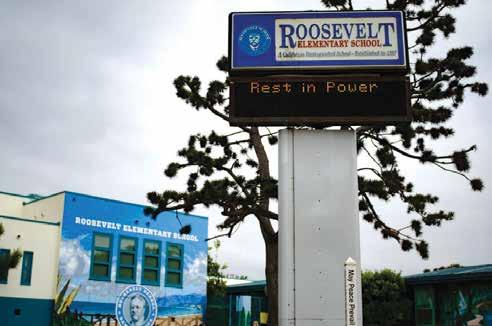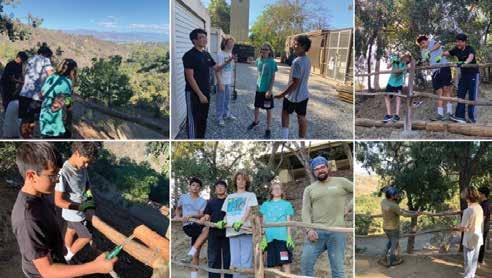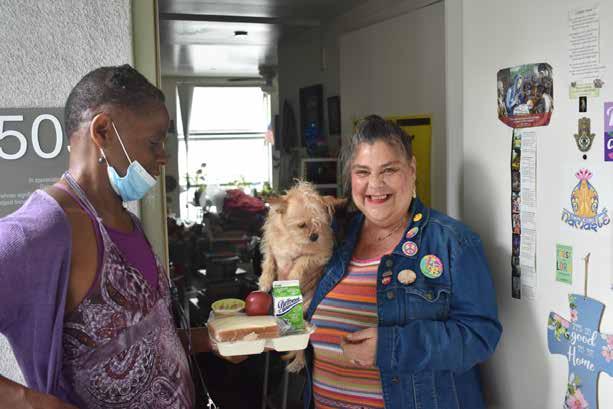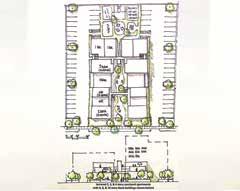Loews Santa Monica Beach Hotel Celebrates



The separation of the Santa Monica Malibu School District has moved forward in an important way. The discussion between the two school districts since April has lead to the creation of a framework to separate the two from one another that both sides can agree with.
As detailed in the official termsheet, the two districts have agreed on “A conceptual financial model to insure both districts maintain sufficient revenue and revenue growth to provide the same or greater level of educational programs to students in both territories. A description of agreements that the City and the District will need to finalize, including a tax-sharing agreement, operations agreement, and joint powers agreement, to fully implement the unification. The pursuit of special legislation to assist in the implementation of the unification. A detailed timeline of the process.”
Jon Kean, SMMUSD Board Member said, as quoted in the press release, “This process we’ve identified reflects countless hours of negotiations and hard work on both sides,” Jon Kean, SMMUSD Board Member, said. “Unification has been discussed, debated and pursued many times over the last few decades. The commitment by both sides to move forward under this framework represents the first time that we have been able to mutually agree upon an equitable financial model. While there is work left to do, we have reached an historic moment in this process.”
Malibu Mayor Paul Grisanti said, as quoted in the press release, “After years of hard work and negotiations, we finally have a viable framework for an independent Malibu Unified School District. We would not be here without the hard work, dedication, and compromise made by the District and the City’s negotiating teams. Now that the Term Sheet has been accepted by both the SMMUSD Board of Education and the Malibu City Council, I am hopeful that the process and framework set forth will guide us to the ultimate goal of two separate school districts.”
The process, stated in the framework,
 By Keemia Zhang
By Keemia Zhang
Santa Monica has placed an indefinite moratorium on a previous directive that ordered Santa Monica Police Department (SMPD) officers to cite cars that parked illegally on driveway aprons and parkways, under section 3.12.380 of the Santa Monica Municipal Code.

The ordinance, announced last month, was slated to go into effect at the beginning of November before city staff stated that it would be suspended for review until further notice.

Santa Monica resident Leah Mendelsohn noted that she was informed of the measure being backpedaled during a phone call with City Staff on Halloween. Mendelsohn, alongside fellow advocate Jason Axe, had
spearheaded a community effort to repeal the ordinance, petitioning the City to address the issue.
City Communications Manager Constance Farrell announced last week that the city had been “evaluating community feedback” and would “‘provide staff the opportunity to consider and bring forward alternatives”, suspending all ticketing enforced by the ordinance.
“It’s personal for me,” Mendelsohn said. “Many of my neighbors with children, or who have disabled people in their families, find it easier to park on driveway aprons in order for them to access their car. It’s just easier.”
She also criticized the City purportedly citing “inequity” as one of the reasons for the original ordinance. “There’s so much bigger inequity in this city, it doesn’t make sense.”
Farrell indicated that City would “determine what changes are necessary to ensure sidewalks remain accessible” and stressed that
safety,
Police are searching for four suspects wanted for robbing a Santa Monica jewelry store in broad daylight.

According to the Santa Monica Police Department (SMPD), on November 20 around 3 p.m., five individuals entered a local jewelry store and committed grand theft.
Two suspects, Suspects 2 and 3, walked into the jewelry store together and approached the salesperson. Shortly thereafter one of them signaled for others to enter the store.
During the crime, four suspects distracted the employee while Suspect 1 walked to the back of the store and took jewelry from the safe and display cases.
“The female suspects were wearing long skirts used to conceal the stolen items and may appear pregnant to help avoid suspicion,” the SMPD said. “All suspects were able to exit the store without the salesperson realizing the theft had occurred.”
The suspect vehicle involved is a 20042005 white Toyota Sienna, police say. Anyone with any additional information pertaining to this incident or the suspects is encouraged to contact SMPD Detective Zamfirov at (310) 458-8398, (peter.zamfirov@santamonica. gov), Sgt. A. Lozano at (310) 458-8414 or the Watch Commander (24 hours) at (310) 4588426.

 By Sam Catanzaro
By Sam Catanzaro

A car drove over the bluffs at Palisades Park in Santa Monica over the weekend.
According to the Santa Monica Police Department (SMPD), on Saturday around 12:25 a.m. dispatchers received multiple calls regarding a vehicle that drove over the bluffs at Palisades Park near the Montana Avenue stairs.
Police say the vehicle had driven west on Montana Avenue into Palisades Park crashing through the barrier and landing approximately 50 feet west into the bluffs.
“Officers contacted two occupants who were inside the vehicle. Both sustained minor injuries and were transported to a local hospital
with non-life-threatening injuries. The driver was subsequently cited for felony DUI,” the SMPD said.
A crane was requested and responded to remove the vehicle from the bluffs, according to the SMPD.





















Santa Monica High School (Samohi) announced that 46 orchestra student musicians have been chosen, by audition, to participate in the highly selective California Orchestra Directors Association (CODA) honors orchestra program planned for December. Chosen by a committee of experts through a blind audition process, a total of 101 student musicians were selected from across the state for the symphony orchestra, of which 27 are from Samohi, while a total of 18 out of 97 total students across California were also chosen for the string orchestra from Samohi.
The students will join exceptional student musicians from throughout California in San Diego, accompanied by Directors Jason Aiello and Jim Wang, to work with their respective orchestras and their esteemed guest conductors.
“Our student musicians have such passion and commitment to their music studies,” said Samohi Principal Marae Cruce. “We are very proud of our Samohi
programs, our directors and these students who are very deserving of this tremendous honor.”
The purpose of the CODA is to promote school orchestras in California by providing quality honor orchestra experiences to high school students. CODA also facilitates an exchange of instructional strategies and ideas for the school orchestra director and provides a community and forum for school orchestra directors.
The symphony orchestra will be performing Mothership by Mason Bates, Huapango by Pablo Moncayo and Symphony No. 2 in D major, Op. 43, IV. Finale by Jean Sibelius, conducted by Michael Gerdes, Director of Orchestras at San Diego State University.
The students selected to participate from Samohi include: Mattin Aframian, Violin; Gabriel Ceguerra, Viola; Ethan Clark, Trombone; Franklin Daley, French horn; Lorelei Deutsch, Cello; Allison Gee, Viola; Parisa Ghassemi, Harp; Natalia Guerra, Bass; Peter Jarvis, viola; Aerin Lee, Violin, Aiden Lee, Violin; Connor Lee, Bass; Shannon Lee, Bass; Sarah Macwan, Violin, Noor Memarzadeh, Violin; Sarah Moeller, Bass; Charlotte Moss, French Horn; Samantha Posell, Bassoon; Hannah
Rand, Viola; Yelena Sahrai, Violin; Alex Sebastian, Viola; Marina Shickler, Violin; Henry Sullivan, Violin; Joshua Tang, Bass Clarinet; Luca Trevellin, Bassoon; Cassidy Walther, Cello; Sam Wessling, Trumpet; Elizabeth Yesilevsky, Violin.

The string orchestra will be performing Ferial, from Estampas Mexicanas by Jose Elizondo, Romanian Folk Dances by Bela Bartok and St. Paul’s Suite, movements 1, 3, and 4 by Gustav Holst, conducted by Dr. Alexander Kahn, Director of Orchestral Activities at Sonoma State University.
The Samohi students selected to participate include: Naomi Altman, Viola; Feben Ayele, Violin; Alessandra Cruz Rivera, Violin; Grayson Fitzgerald, Bass; Hoyt Gallagher, Cello; Mia Gobel, Violin; Iliyan Kanji, Violin; Shayl Khatod, Violin; Joia Massee, Bass; Jackson Mayeda, Viola; Benjamin Ostrovsky, Cello; Daniel Ostrovsky, Cello; Christopher Rhee, Violin. Salomon Singer-Portnoy, Violin; Soren Thanawalla, Cello; Edward Wallace, Bass; Kyle Wang, Violin; Naomi Xia, Violin.

The students will each learn their respective pieces on their own, outside of and in addition to their school repertoire, and then have one day to rehearse together with their orchestra peers at San Diego
State University on Friday, December 2. The performances will be held at Wilson Middle School, Saturday, December 3, 2022 at 1 p.m. The concert is free and open to the public: Wilson Middle School, 3838 Orange Ave, San Diego, CA 92105.

SMMUSD makes music education a priority, providing instruments and music instruction to all interested students starting in fourth grade, all the way through matriculation. Samohi orchestras have performed in world class venues across the United States and the world, and the program is recognized as one of the best in the country. To learn more about, or to donate to the Santa Monica High School orchestra program please visit: www. samohiorchestras.com





Short-term program has no enrollment fee & is one of a dozenplus such noncredit certificates






 By the Public Information Office, Santa Monica College.
By the Public Information Office, Santa Monica College.
What comes with no enrollment fee, is created especially to meet workforce needs, and gets those who want to jumpstart a career to their goal ASAP? The answer: noncredit programs at Santa Monica College. One of the lesser known gems at a local community college perhaps known best for its stellar record in transfer education, these shortterm, career/competency-driven programs are growing—from a mere handful several years ago, there are over 19 such noncredit certificates available (with more in the works) in fields including customer service, sustainability, bicycle maintenance and more. The latest noncredit offering— launched during the Fall 2022 semester—is the Certified Nursing Assistant program. This feature offers a look back at the early days of this latest SMC noncredit program’s maiden voyage:
Trainees Isaura Gutierrez and Iris Carrillo are taking “patient” Henry Munguin’s vital signs. Once they’ve eased him from the hospital bed into a stable sitting position, Gutierrez wraps the blood pressure cuff around Henry’s arm. Iris places a digital thermometer in his mouth. Then they carefully maneuver him into the wheelchair waiting by his bedside.
“Perfect,” says SMC Health Sciences instructor Juliet Carter-Daley, the program’s head instructor, as the students complete the transfer.
It’s their second day focusing on longterm care. Still to come are modules on rehabilitative nursing, observation and charting, death and dying, and patient abuse. Henry is a CNA trainee playing the role of an elderly patient in a mock hospital ward on the Bundy Campus.
Week-four and week-five saw the trainees outside the classroom and in a skilled nursing facility. Under Carter-Daley’s watchful eye, they assisted RNs caring for real residents at Marycrest Manor in Culver City.

Five of the 11 SMC trainees continued their training in the follow-on Home Health Aide certificate program, also led by CarterDaley and new this semester. That two-week, 54-hour program concluded its inaugural run October 14.
The push for these noncredit certificate courses is driven by urgent workforce needs.
“We have a terrible shortage of certified
nursing assistants, just as we have a terrible shortage of registered nurses,” says Eric Williams, director of SMC’s Nursing Program and interim associate dean of health sciences. “Our goal is to build a pipeline.”
The CNA’s job is to support registered nurses by providing basic hygiene and patient care. According to the U.S. Bureau of Labor, there are fewer than 100,000 CNAs in California, a state with six million senior citizens. This yawning workforce gap converges with rising demand for lowcost, easy-to-access learning opportunities for “post-traditional” students—people who increasingly look to community colleges for vocational training.
While California has hundreds of CNA training programs—there are 130 in Los Angeles County alone, including seven at area community colleges—many require three months to complete, and average tuition and fees run around $1,800. At forprofit colleges, that price tag gets steeper.
The beauty of SMC’s new program is that it’s compressed into just five weeks. And because it’s noncredit, it can be delivered tuition-free. “Noncredit classes have no enrollment fees,” explains Scott Silverman, dean of noncredit and external programs.
In all other respects, the new program is similar to for-credit CNA certificate programs. No grades are given, but students receive progress indicators and the certificate is noted on their transcripts.
Enrolling in “Health 985 and 986: Certified Nursing Assistant” requires committing to three weeks of intensive foundational training followed by two weeks of clinical practicums in a skilled nursing facility. The program is fully accredited, and it’s rigorous. Students completing the 180-hour curriculum are eligible to sit for the NNAAP competency exam required for state licensure.
“My students are very focused,” says Carter-Daley, an RN with extensive prior experience teaching CNA courses. “They’re working hard, and they’re really making it a priority to get this done.”
Classes—comprised of 17 lectures and 17 lab modules—meet five days a week, eight hours a day. “They come in at 7 a.m., and they’re ready to go,” she adds.
The effort pays dividends almost immediately.
“Some want to become RNs, so they’re



Head to the beach this December to experience the hotel’s seasonal family-friendly activities
This year, Loews Santa Monica Beach Hotel brings the magic of the season to life with festivities fit for Saint Nick himself. Gather the family this season and head to the beach this December to experience the hotel’s seasonal family-friendly activities.
Guests are visitors alike are invited to celebrate the holidays with dining experiences like Breakfast with Santa, Tea with Twist with performances by Elemental Music, and Brunch with Santa Paws in partnership with Healthy Spot, as well as live musical entertainment, a Seaside Cinema series screening classic holiday films, letter writing to Santa, and much more. Many of the experiences are open to non-hotel guests and locals as well.
Breakfast with Santa: Enjoy holiday breakfast with Santa! Feast on breakfast favorites, make reindeer antlers, catch Santa’s Magical Elf, and more. Adults will receive a complimentary mimosa. Takes place on three Sundays in December (12/4, 12/11, 12/18) at 10:30 a.m. $85 per adult and $45 per child.
Tea with a Twist: Enjoy our version of a tea service, with tea-infused cocktails and a selection of sweet and savory bites along with special performances from Elemental Music & Choir—a Santa Monica non-profit

working with more than 300 local up-andcoming young musicians. Each event will have a performance from the students’ winter
concert repertoire. $79 per person, a portion of proceeds from each ticket will benefit Elemental Music. Takes place December 3,
10, and 17.
Live Holiday Music: Take in nostalgic and classic holiday tunes in the hotel lobby, including:
• All That Jazz: Thursdays from 5:30-8:30 p.m.
• Acoustic Evenings: Friday from 6-9 p.m.
• Holiday DJ: Saturday 6-9 p.m.
Seaside Cinema – Holiday Edition (hotel guests only): ‘This the season for holiday movies…beachside. Seaside Cinema Holidays features classic holiday films for the whole family including Elf, The Polar Express, Home Alone, and more. Seasonal culinary treats are available for purchase. Located on the 7th floor landing every Saturday (as well as select holidays) in December from 3-5 p.m.
Holiday Drag Brunch: A holiday version of the monthly Drag Me to Brunch performance. Join RuPaul Queen and Host Naysha Lopez, along with top drag performers, for a festive and lively drag brunch. $85 ticket includes buffet and a complimentary mimosa. Takes place on December 18 at 11 a.m. Reservations strongly encouraged for guaranteed seating.
For those looking to book a holiday getaway: Home for the Holidays – Seaside Family Escape Package: Sip on holiday cocktails, take advantage of a $75 daily credit (or $200 daily credit if you book before December 1) to use at your choice of Breakfast with Santa or Tea with A Twist, and take in all of the Seaside Holiday festivities. Guests who book the Home for the Holidays package will also receive priority access to reserve a spot at one of the signature events, in addition to complimentary parking and waived resort fee. Enjoy our Hot Cocoa Bar at check in (if visiting on the weekends). For additional information or to book, please visit: https://www.loewshotels.com/santamonica/specials/seaside-holidays
 By Keemia Zhang
By Keemia Zhang
Last month, Ari Candela, patrol leader of Boy Scout Troop 223, led a community service effort, dubbed a “good turn” trip as part of a Scouts program designed to encourage patrols to give back to their community. For the project, Candela chose Tree People, an environmental advocacy group that encourages the preservation of ecosystems across the Los Angeles area.
He previously visited the organization several years prior, where he was given a seed that grew into a pine tree in his backyard. Inspired by this and his love of nature, Candela led his Palisades-based troop to fix a termiteinfested handrail on a Beverly Hills hiking path, permitting visitors to enjoy the space. I spoke with Candela to hear about his work with the Scouts and community service.
Keemia Zhang: So Ari, tell me about how you became a Boy Scout.
Ari Candel: So originally my friends wanted me to become a Boy Scout and then – like so
basically, before you actually join Scouts, you can go on like a campout to experience and see what you’re getting yourself into, and I enjoyed the campout so I just decided to commit.
KZ: That’s really cool. Do you have anything you enjoyed most about it?
AC: Just being able to meet a lot of people from different schools and just having different camping experience. And one thing specifically was for this past year for highventure – basically when the older scouts go on like a trip, half of the trip went to Denmark for the Scout Jamboree.
KZ: Awesome. So for your good turn trip, do you wanna tell me more about why you chose the environment for your topic?
AC: I enjoy just being in nature, I go hiking with my parents a lot and we always enjoyed that, so it’s like trying to get back to that and give back to Mother Nature.
KZ: For your actual good turn trip, can you tell me about what you saw and did that day?
AC: We saw a lot of people hiking but basically there was this handrail that another Scout troop had made during an Eagle project. There was bark on the handrail, and termites were biting and destroying it so we removed the bark to get rid of the termites.
KZ: Did you have a favorite and least favorite part of the day?

AC: Least favorite is that it was a bit hot, favorite is just to give back to my community and do community service. My memory is just being able to help other people because now the handrail will be able to stay up for a longer amount of time and other people will just keep it in good shape.
KZ: Do you plan on doing more things like this when you’re an Eagle Scout?
AC: When I’m an Eagle Scout I will have to do a project where I create something for a nonprofit organization and it’s mandatory to get a specific amount of hours working on it.
KZ: And how does giving back to your community make you feel?
AC: It makes me feel happy because it’s just nice to give back to your community whenever you can, and there are lots of nice people who do nice things for each ot

doing this certificate as a way to get into a nursing program,” Carter-Daley says. Others will find steady jobs in hospitals and skilled nursing facilities. CNAs in California earn on average $40,000 a year.
Jose Abularach, 24, and his sister Katie, 20, are learning a lot in the class. Both are current SMC students eyeing a pre-nursing major. When they heard about the CNA program through SMC’s Adelante Program, they signed up immediately.
“Normally this class is very expensive,” Abularach says. “I know—because we’ve been looking at other programs.”
Originally from Guatemala, the siblings live with their parents in Culver City. For Katie, the first day cemented her decision to apply for admission to SMC’s selective nursing program. Jose is still on the fence. For now, he’s an undecided major working fulltime as a Starbucks barista.
Whatever the future holds, Jose is grateful to have this credential under his belt.
“I will always have these skills,” he says.
For Iris Carrillo, 21, SMC’s noncredit CNA certificate came as a godsend.
Inspired by her grandmother, a nurse back in her native Mexico, Iris dreams of a career in travel nursing. In June, she finished the two-year ADN degree at Cal State Fullerton and is currently applying to BSN programs. Her top choice is Ohio State University, but she’s also looking at schools in Mississippi and Washington.
Currently, Carrillo works as a board
"There's no place like Meals on Wheels West. They are loyal, kind, and compassionate for doing what they do. You can count on them to go the extra way."
certified behavior analyst for Autism Learning Partners, and she has a second job as an on-site chef for various caterers. To get a jump on GE requirements for her BSN, she’s enrolled in two online courses this fall.
Clearly, she has no free time, but over the summer she started looking into CNA certificate programs. In some states, though not in California, the credential is a requirement for nursing school admission. It’s also a terrific resume booster. The cost and time-commitment, however, were great obstacles.
“Some other CNA programs I looked at take a year or half a year,” Carrillo says. “I don’t have that much time. And I don’t have thousands of dollars on top of the nursing school tuition I will have to pay.”
The CNA training she’s receiving at SMC is “a crucial part of my education, because it allows me to be a shadow and watch how nurses operate. To eavesdrop. To see what works for them and what works for me.”
For now, that means taking Henry for a ride around the skills lab.
Rolling the wheelchair back to the bedside, Isaura Gutierrez and Iris Carrillo hold him in a careful two-person hug, lift and pivot his torso, then gently arrange his legs and tip him back into a recumbent position. Using the sheet underneath, they shift him up the bed, lowering his head and arms on surrounding pillows. Draping his form with the blanket, they bid him: “Goodnight.”
For more information on all of Santa Monica College’s noncredit programs and classes, visit smc.edu/noncredit.

Marianne, MOW West Food & Shelter client
26% of MOW West's clients are formerly unsheltered. increase in our Food & Shelter clients over the last three years. 78% Food & Shelter promotes stability, health, & wellness, allowing clients to reintegrate into society.

by turning segments of streets/alleys into parks.
The future lies within our cities, but our cities are crumbling! Cities are home to over 1/2 the world’s population and in 20 years will be home to 2/3rds! They are the focal points of poverty & health, water & energy, food & waste, transportation & congestion, climate change & environmental degradation, innovation & economic growth – with changes in climate, economics, and social media creating a new and ever changing reality.
So where is this increasing growth and transformation headed? What will managing this growth require? What direction will the rapid shifts in communication take us? If our cities fail, so will we!
The American dream has been focused on ownership and 80% of wealth is created in cities where people find opportunities. Will we continue to enjoy the benefits of cities – the restaurants & cafes, the art galleries & cultural facilities, parks & landscaped environmentswithout crime, traffic, and pollution?
And the dream of ownership is becoming one of sharing – not me, but us! Will our future experience be increased sharing of resources –shared workspace, shared transportation, shared living quarters? Apartments are shrinking in area with quickly diminishing privacy as developers
densify to increase profits! We’re facing an unprecedented scale of planning which we frankly don’t know how to handle with the future of cities and urban design requiring cross disciplinary integration. What will managing this growth require and what are the barriers? And in our environment where will the water required to support such growth come from in this time of extended drought?
A healthy city will need to balance economic & resource efficiency – accommodating growth while lowering resource consumption. And even with computers & teleconferencing, faceto-face opportunities will still prevail. But with LA County’s sprawl, enormous distances to jobs with public transportation while also managing childcare is not acceptable.
So how do we keep Santa Monica from also falling deeper in this abyss? How do we stop Developers from “piecemealing” our city which has proven very expensive. There are 5 objectives I feel the City Council should consider to keep Santa Monica from continuing to crumble still further!

1) Undertake affordable housing on public property!
2) Provide incentives to promote responsible, controlled development on the boulevards!
3) Initiate zoning code revisions & incentives to rid the city of these faceless 6-10 story block buildings with in-line balconies reminiscent of computer punch cards.
4) A master plan to control our hemorrhaging debt.
5) Providing more neighborhood green space
1. A viable approach to affordable housing: As an architect & planner for more than 50 years, I have been involved in the design of several thousand affordable units – 2, 3 & 4 story terraced courtyard housing primarily on excess, vacant public land. The city, developer, and public all benefitted from the significantly reduced land & construction costs!

According to current online records, Santa Monica City owns 10% of the 5,312 acres within city limits, and approximately 10% of that is vacant. If only half of the vacant 531 acres is usable, it would provide 11,700 units at a desirable garden apartment density of terraced 2, 3, & 4 stories! Per the example shown on a one acre site, you could easily build 44 units/ acre with surface parking and bicycles instead of subterranean, along with sitting & picnic areas, volleyball & basketball, and gardening & playground areas. Garden apartments with open space compared to the 113 units per acre currently proposed and jammed in over 2 levels of subterranean parking on the Gelson’s site, of which only 10% of the units are considered affordable.
Overall costs could be reduced – land costs of 25-30% would be 0%, low-rise type V construction costs would save 15-20% (especially with the coming digital fabrication of buildings saving on parts, labor, and construction time along with less neighborhood intrusion) and saving 10-15% of financing costs! And reduced permit costs and expedited review could save another 10%.
And over a 15-20 year period, the affordable rents would repay the city its land value, provide a fair return to the developer, and more importantly provide tenant equity leading to apartment ownership after a 15-20 year mortgage is paid off with tenant rents! This would provide housing for approximately 26,000 or 28% of our current population – if this amount of housing is even necessary, which is unlikely given the dire water situation? After +/- 40 years, it’s time to stop going down the wrong street!
tax exemptions and streamlined processing procedures to offset this totally unnecessary visual & physical boondoggle.
4. The absolute necessity of a citywide Master Plan for our future:
Instead of $5m tentatively budgeted in the pending 2023 SM budget for a master plan for the SM airport, spend a similar amount for a citywide master plan – one that the city in its 138 year history has never had?! Instead, we have juggled and piecemealed development. Let’s not piecemeal our master planning.
What kind of city do we want to become? What should our sources of revenue be? What is the image we would like to project to outsiders? What is the scale, height, and massing appropriate for the city’s image? And will we be a net zero city, and if not, what are our energy goals? Without a master plan, this is a very stupid and expensive way to run a city, especially when the current computer age allows continuous updating!
We can’t continue allowing Developers to rebrand Santa Monica! What is our vision? What are we going to insist our Council do about it?
5. Turning segments of residential streets into parks:
2.
In Santa Monica, we have approximately 8 miles of boulevards with approximately 80% being either vacant, surface parking, or 1 story retail with the other 20% primarily 2 stories. Again by offering tax and processing incentives, the vacant properties, parking lots, and 1 story properties could be developed with stepped 2, 3, & 4 story buildings having ground floor meandering sidewalks and courtyards, upper level terracing, and boulevards turned into landscaped parkways with thousands of apartments or condos together with surrounding neighborhoods where residents could walk to jobs, shop, or just relax in the nearby courtyards and mini-parks.
3. Zoning Code revisions:
Although the development industry (west coast, east coast, and abroad) has successfully convinced Governor Gavin Newsom and the State legislature to unnecessarily and substantially increase housing across the state with code revisions allowing 6-10 story building heights and decreased property line setbacks along with the demise of R1 zoning, we are still able to offer developers meaningful
For the past 5 years, I’ve been working on and processing my idea for small neighborhood parks in every residential neighborhood throughout the City of Compton and eventually throughout every urban community in the country. In a typical neighborhood of +/- 24-30 residential blocks defined by perimeter arterial streets, an “active” & “passive” park could be built at each end of the neighborhood on the side street of a residential block without interfering with residential or emergency access.
C’mon City Council, get your act together and do the job the Residents need & elected you to do! This is not a political job you’ve selected, and it is certainly not a beauty contest you’ve won - this is a planning job!! We can’t continue allowing Developers to rebrand Santa Monica –What is our vision, our future? Are you up to the task???
Ron Goldman FAIA for SMa.r.t.
Santa Monica Architects for a Responsible Tomorrow
Thane Roberts, Architect, Robert H. Taylor AIA, Ron Goldman FAIA, Architect, Dan Jansenson, Architect & Building and Fire-Life Safety Commission, Samuel Tolkin Architect & Planning Commissioner, Mario FondaBonardi AIA & Planning Commissioner, Marc Verville M.B.A, CPA (Inactive), Michael Jolly, AIR-CRE.
For previous articles see www.santamonicaarch.wordpress.com/ writing

